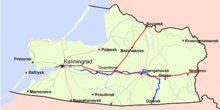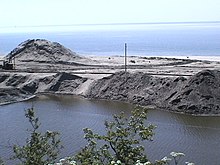


The Amber Coast is the name given to a coastal strip of the Baltic Sea in the northwest of Kaliningrad ( Russia, Kaliningrad Oblast, Sambia Peninsula, formerly northern East Prussia in Germany). In this area amber ( Baltic amber) has been excavated since the mid-19th century and up to today in open-pit mining. Two deposits – Palmnikenskoe and Primorskoe, containing 80% of world amber reserves, were found near Yantarny on the Western coast of the Sambia Peninsula in 1948-1951’s. [1]
History
Scientists believe that amber was deposited during the Upper Eocene and Lower Oligocene in a delta of a prehistoric river, in a shallow part of a marine basin. [2] In addition to the coast near Kaliningrad, amber is also found elsewhere in the Baltic Sea region. [2] The deposits are found mostly in the "blue earth glauconite", a layer 1 to 17.5 meters thick found 25 to 40 meters from the surface. [2] In addition to the Sambia region, amber is gathered in noticeable amounts at German, Polish and Lithuanian Baltic beaches [2] (areas of the Bay of Gdańsk as well as the Vistula Lagoon), the western coast of Denmark [2] and the Frisian Islands. [2] Small amounts of Baltic amber can even be found outside the Baltic region, for example on the coastline of the south east of England. [2]
However, about 90% [3] [4] to 98% [2] of all output of amber has been produced in the Sambia region (now a Russian exclave, formerly in Eastern Prussia and the Polish–Lithuanian Commonwealth). [2] The Sambian amber-producing region is a square of about 30–40 km (20–25 miles), although geologists estimate there are deposits beyond the region of the main excavations. [2] A potential nearby source of amber is the Courish Lagoon. [2] Amber excavation is overseen by the Russian Amber Company (Ruskij Jantar). [2] [5]
The Amber Coast is mentioned as early as by Tacitus in his work Germania. [6] [7]
Other uses
Another coastal strip referred to as “amber coast” is the Costa de Ambar (also known as “Costambar”) in the west of Puerto Plata ( Hispaniola, Dominican Republic). In this area there are a number of small shaft mines, from which is excavated the so-called " Dominican amber". [8] The Dominican amber production site is the world's second-largest, although compared to the Baltic region it is "a distant second". [9]
References
- ^ "The History of Russian Amber, Part 1: The Beginning", Leta.st
- ^ a b c d e f g h i j k l Patty C. Rice (15 September 2006). Amber: Golden Gem of the Ages. Patty Rice. pp. 22ff. ISBN 978-1-4259-3849-9. Retrieved 7 March 2011.
- ^ Gemological Institute of America; American Gem Society (1996). Gems and gemology. Gemological Institute of America. p. 74. Retrieved 8 March 2011.
- ^ "Amber Trade and the Environment in the Kaliningrad Oblast". Archived from the original on 2012-07-06. Retrieved 2011-03-08.
- ^ Patty C. Rice (15 September 2006). Amber: Golden Gem of the Ages. Patty Rice. pp. 116ff. ISBN 978-1-4259-3849-9. Retrieved 7 March 2011.
- ^ K. Andrée: Der Bernstein und seine Bedeutung in Natur- und Geisteswissenschaften, Kunst und Kunstgewerbe, Technik, Industrie und Handel. Königsberg 1937.
- ^ F. Waldmann: Der Bernstein im Altertum - Eine historisch-philologische Skizze. Fellin 1883.
- ^ George O. Poinar, Jr.: Life in amber. Stanford 1992
- ^ "Fossil Amber or Fossil Resin". Virtual Fossil Museum. Retrieved 10 March 2011.
External links
- Amber deposits Archived 2019-08-26 at the Wayback Machine
- The Economic History of Amber
- Baltic Amber